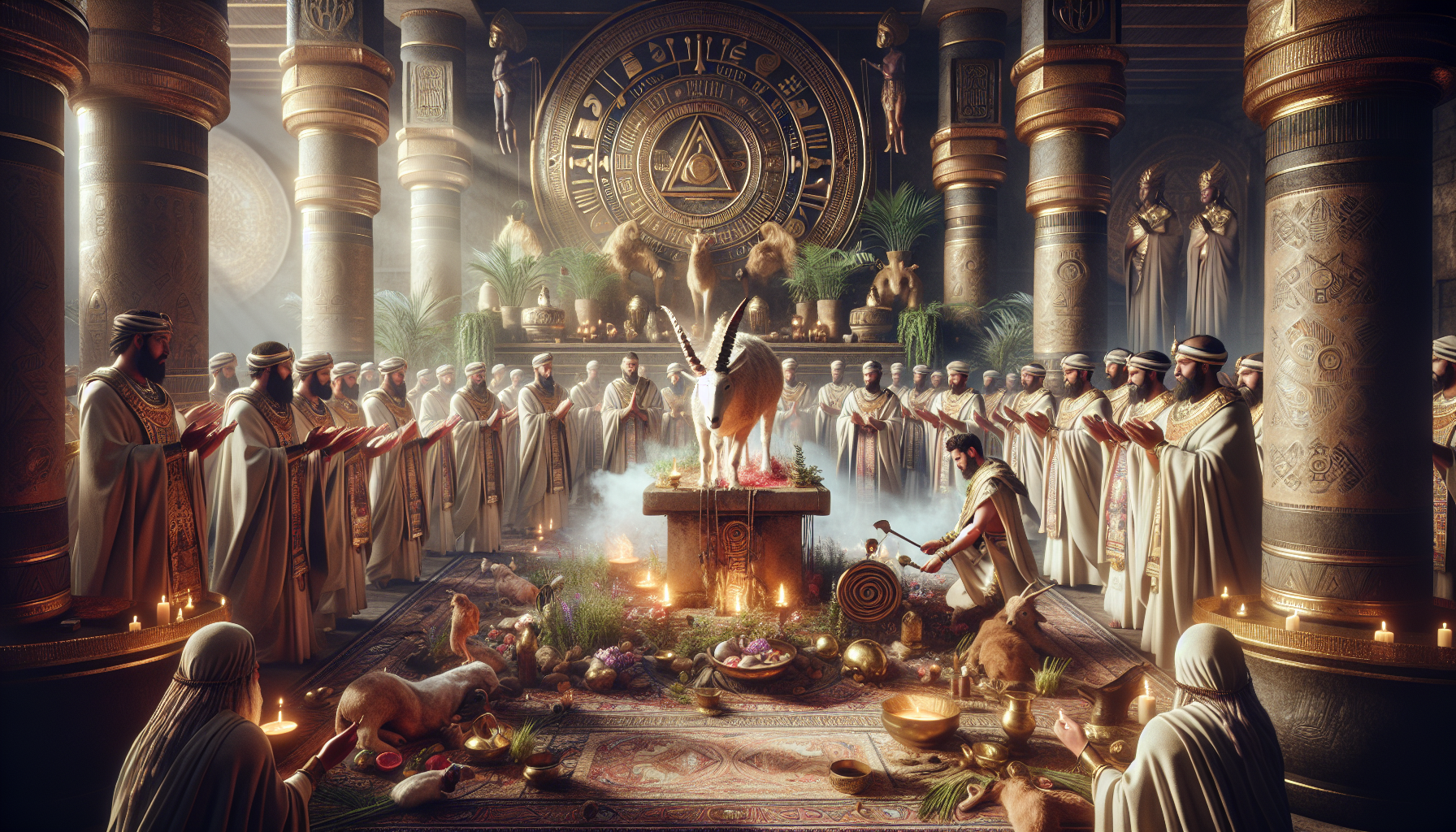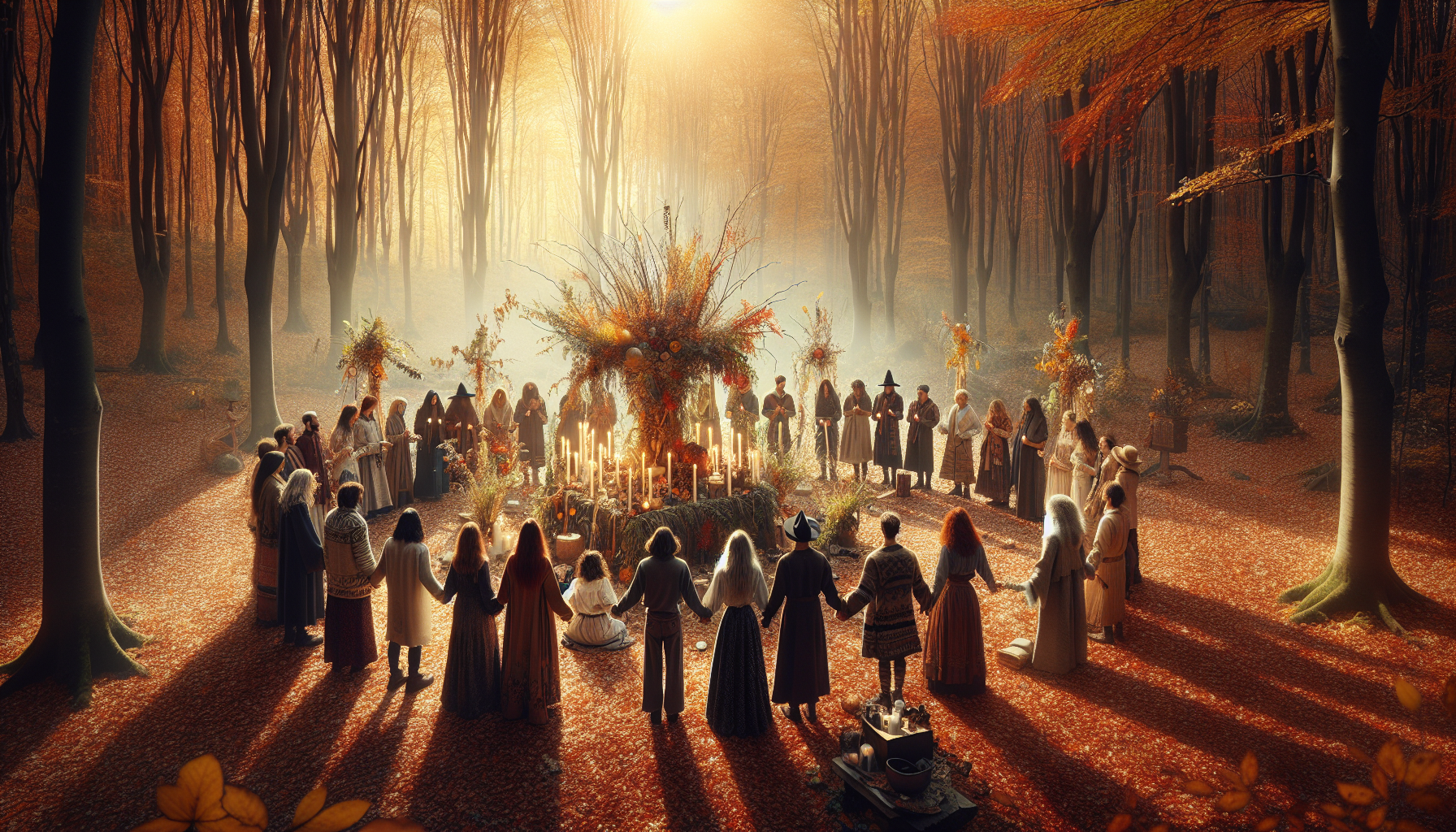In a world where the ancient and the modern often collide, the practice of animal sacrifice stands as a profound testament to humanity’s enduring quest for connection with the divine. 🌿 This ritual, rooted in a myriad of cultures and spiritual traditions, transcends time, geography, and religion, offering a glimpse into the sacred exchanges that have shaped human existence. The notion of sacrifice evokes a complex tapestry of emotions and ethical considerations, yet its essence lies in the energy exchanged between the earthly and the divine, the tangible and the mystical. As we embark on this exploration, we aim to unravel the intricate layers of meaning and symbolism behind animal sacrifice, inviting you to ponder its role in the spiritual and cultural landscape of past and present.
Our journey will traverse the historical corridors where sacrifice was not merely an act of devotion, but a pivotal element in the social and religious fabric of civilizations. From the ancient Egyptians, who saw animals as embodiments of gods, to the Vedic rituals in India, where offerings were made to maintain cosmic order, each tradition offers unique insights into the values and beliefs of its people. We will delve into the anthropological perspectives that explain why such practices emerged, and how they have been interpreted across different eras and societies. Through this lens, animal sacrifice becomes a mirror reflecting human attempts to navigate the mysteries of life, death, and the hereafter.
As we peel back the layers of this ancient practice, we will also address the contemporary discourse surrounding it. In a world increasingly conscious of animal rights and ethical considerations, how does the practice of animal sacrifice fit into modern spiritual practices? We will examine how various religious and cultural groups have adapted these rituals to align with contemporary values, creating a dialogue between tradition and progress. By exploring the energetic exchange inherent in these sacred offerings, we aim to foster a deeper understanding of how sacrifice, in its many forms, continues to shape and define human spirituality. Join us on this enlightening journey as we seek to illuminate the profound connections between the sacred, the sacrificial, and the spiritual. ✨
Introduction to Animal Sacrifice: Historical Context and Cultural Significance
Animal sacrifice has been a significant part of human culture for thousands of years, often serving as a means of communicating with the divine. This ancient practice is rich in historical context and carries diverse meanings across various cultures. Historically, animal sacrifice was not merely an act of slaughter but a sacred ritual, deeply embedded in the religious and spiritual lives of communities. For instance, in ancient Greece, offerings to gods were seen as a necessity to appease deities and ensure prosperity. Similarly, in Hinduism, certain sacrifices were believed to be essential for maintaining the cosmic order.
Over time, the reasons and methods of animal sacrifice have evolved. While some societies have moved away from the practice, others continue to uphold it as a vital part of their spiritual traditions. The symbolism associated with animal sacrifice often revolves around themes of life, death, and rebirth, highlighting the cycle of existence and the interconnectedness of all living beings. This practice has also been used as a tool for social cohesion, bringing communities together in shared rituals and reinforcing cultural values and beliefs.
The Role of Animal Sacrifice in Ancient Civilizations
In ancient civilizations, animal sacrifice was more than just a religious duty; it was a vital part of the societal fabric. The Egyptians, for example, believed that sacrifices were necessary to maintain the favor of the gods and ensure the balance of the universe. In their complex religious ceremonies, animals such as bulls and birds were offered to deities as a sign of devotion and respect.
The Aztecs, on the other hand, practiced animal sacrifice as part of their intricate calendar of rituals, which were crucial for maintaining the cosmic order. Animals like dogs, butterflies, and snakes were sacrificed to honor gods such as Huitzilopochtli and Tlaloc. The offerings were believed to nourish the gods, who in turn would grant prosperity and fertility to the land.
In ancient Mesopotamia, animal sacrifices played a similar role in religious practices. The Mesopotamians offered animals to gods in temples, believing that such sacrifices would ensure the well-being of their cities and the success of their agricultural endeavors. This practice also extended to household rituals, where individuals made offerings to personal gods to seek protection and favor.
The Energetic Exchange in Animal Sacrifice
Animal sacrifice is often viewed as an energetic exchange between humans and the divine. This exchange is rooted in the belief that the life force of the sacrificed animal transfers to the spiritual realm, thereby strengthening the connection between the earthly and the divine. This concept of energy exchange can be found in various cultural and religious contexts.
In many African traditional religions, the act of sacrifice is seen as a way to release spiritual energy that can appease ancestors or gods. The sacrificed animal’s spirit is believed to carry messages or requests from the living to the spiritual world. This exchange is considered essential for maintaining harmony and balance within the community and the cosmos.
In Hinduism, the practice of animal sacrifice, known as bali, is conducted during specific festivals and rituals. The energy released during the sacrifice is thought to purify the surroundings and bring blessings to the participants. This belief in the transformative power of sacrifice highlights the intricate relationship between humans, animals, and the divine.
Contemporary Interpretations of Energetic Exchange
Today, the idea of energetic exchange in animal sacrifice is interpreted in various ways. Some modern practitioners view the sacrifice as a form of offering life energy to the divine in exchange for blessings or guidance. This perspective emphasizes the reciprocity inherent in the practice, where both humans and the divine benefit from the exchange.
Others see the energetic exchange as a symbolic act, where the sacrifice represents the surrender of personal desires or ego to a higher power. This interpretation aligns with broader spiritual philosophies that emphasize selflessness and devotion as pathways to spiritual growth.
Comparative Analysis of Animal Sacrifice Practices Across Cultures
Animal sacrifice practices vary widely across different cultures, reflecting diverse beliefs and traditions. The following table provides a comparative analysis of animal sacrifice practices in various cultural contexts:
| Culture | Animal Used | Purpose of Sacrifice | Religious Significance |
|---|---|---|---|
| Ancient Greece | Cattle, sheep, goats | Appease deities, ensure prosperity | Offerings to gods, part of major festivals |
| Hinduism | Goats, chickens | Purification, seek blessings | Part of festivals like Durga Puja |
| Islam | Cattle, sheep, camels | Commemoration of Abraham’s sacrifice | Eid al-Adha, expression of faith |
| Aztec | Dogs, butterflies, snakes | Maintain cosmic order | Nourish gods, ensure fertility |
Each of these practices reflects a unique understanding of the relationship between humans and the divine, as well as the role of sacrifice in maintaining that connection. While the specifics of the rituals differ, the underlying themes of devotion, reciprocity, and spiritual exchange are common across cultures.
Video Exploration: Understanding Animal Sacrifice
For a more visual understanding of animal sacrifice practices and their significance, watch this informative video: “The Rituals of Sacrifice: A Journey Through Ancient Traditions” on the “History Uncovered” channel. This video provides an in-depth look at how various cultures have approached the practice of animal sacrifice throughout history.
Ethical Considerations and Modern Perspectives
In contemporary society, the practice of animal sacrifice raises several ethical concerns. The treatment of animals, the necessity of sacrifice in modern religious practices, and the impact on animal welfare are significant points of discussion. As societies become more aware of animal rights, the continuation of traditional practices involving animal sacrifice is being critically examined.
One of the primary ethical considerations is the welfare of the animals involved. Many animal rights organizations argue that sacrifices are inhumane and advocate for alternative methods of offering that do not involve harm to animals. This perspective has led to changes in some religious communities, where symbolic offerings are made instead of actual sacrifices.
Additionally, the necessity of animal sacrifice in modern religious practices is being questioned. As spiritual beliefs evolve, some practitioners are choosing to reinterpret traditional practices in ways that align with contemporary values. This shift reflects a broader trend toward a more inclusive and ethical approach to spirituality, where the focus is on the intent behind the ritual rather than the specific actions involved.
The Future of Animal Sacrifice in Religious Practices
The future of animal sacrifice in religious practices is uncertain, as it navigates the tensions between tradition and modernity. Some communities continue to uphold the practice as a vital part of their spiritual heritage, while others are moving towards more symbolic forms of worship.
As dialogues around animal welfare and ethical treatment continue to evolve, it is likely that the practice of animal sacrifice will undergo further transformations. These changes may involve greater regulation, increased emphasis on humane treatment, and the incorporation of alternative rituals that align with contemporary ethical standards.
Ultimately, the future of animal sacrifice will depend on the ability of religious communities to adapt and reinterpret their traditions in ways that honor both their spiritual heritage and modern ethical considerations. This dynamic interplay between tradition and modernity will shape the ongoing evolution of animal sacrifice practices in the years to come.

Conclusion
In conclusion, the exploration of the energetic exchange in animal sacrifice is a complex and multifaceted subject that intertwines spirituality, cultural traditions, and ethical considerations. Throughout this article, we’ve delved into the historical roots and cultural significance of animal sacrifice, acknowledging its role in various religious and spiritual practices worldwide. We’ve also examined the ethical debates surrounding this practice, considering perspectives that range from cultural preservation to animal rights.
The historical context of animal sacrifice reveals its ancient origins and its evolution across different civilizations. From the rituals of ancient Mesopotamia and Egypt to the sacrificial practices in Hinduism, Judaism, and indigenous cultures, animal sacrifice has been a means of communicating with the divine, seeking favor, and maintaining cosmic balance. These practices highlight the profound connection humans have sought to establish with higher powers through offerings.
The cultural significance of animal sacrifice is evident in its role as a symbol of devotion, gratitude, and humility. In many traditions, the act of sacrificing an animal is seen as a sacred offering, a way to honor deities or spirits and maintain harmony within the community. This aspect of sacrifice emphasizes the interconnectedness of life and the cyclical nature of existence, where life is given to sustain life.
However, the ethical implications of animal sacrifice cannot be overlooked. The debate around this practice often centers on the balance between cultural preservation and the ethical treatment of animals. While some argue for the importance of maintaining cultural heritage, others advocate for more humane alternatives that respect both cultural practices and animal welfare. This ongoing dialogue reflects the broader societal shift towards more compassionate and sustainable practices.
In the modern context, the energetic exchange inherent in animal sacrifice raises questions about the broader implications of our interactions with the natural world. It prompts us to consider how our actions, rituals, and traditions impact the environment and the beings we share it with. This reflection invites us to explore new ways of engaging with spiritual and cultural practices that align with contemporary ethical standards.
The significance of this topic extends beyond the specific practice of animal sacrifice. It invites a broader discussion on how we honor traditions while adapting to evolving moral landscapes. It challenges us to find ways to celebrate our cultural identities while being mindful of the ethical considerations that accompany them.
In light of these discussions, it is crucial to approach the topic of animal sacrifice with an open mind and a willingness to engage in thoughtful dialogue. By doing so, we can foster a deeper understanding of the practices that shape our spiritual and cultural landscapes and find common ground that respects both tradition and modern ethical values.
As we conclude this exploration, we encourage you, our readers, to reflect on the insights gained and consider how they resonate with your own beliefs and values. Engage in discussions with others, share your perspectives, and explore the diverse viewpoints that exist within this topic. By doing so, you contribute to a more informed and compassionate conversation about the practices that shape our world.
Feel free to explore further and deepen your understanding by visiting reputable sources such as , which offers insights into cultural practices and their historical contexts, or National Geographic, where you can learn more about the intersection of culture, ethics, and the environment.
Thank you for joining us on this journey of exploration and reflection. Together, let’s continue to seek knowledge, understanding, and empathy in our quest to honor both tradition and ethical progress. 🌍✨
Toni Santos is a visual storyteller and symbolic naturalist whose creations explore the hidden ecologies and forgotten bonds between humans and nature, as whispered through ancient lore. Through an intuitive and myth-sensitive lens, Toni reveals the sacred choreography between flora, fauna, and human spirit — a world where trees once spoke, rivers remembered, and every herb carried a secret name.
His journey is rooted in the esoteric — in the rituals of forest-dwellers, the botanical codes of shamans, and the unspoken pacts that shaped how ancient peoples lived in deep, reciprocal harmony with the natural world. From sacred groves to serpent-guarded springs, each of Toni’s works reflects a symbolic relationship long obscured by modern forgetfulness.
With a background in visual design and ancestral aesthetics, Toni merges storytelling with sacred ecology. His pieces don’t simply illustrate — they channel. Drawing from myth, mysticism, and lost herbal traditions, he crafts visuals that resonate with the old wisdom: that nature is not background, but kin.
As the creative spirit behind Vizovex, Toni shares collections, visual studies, and articles that illuminate the occulted connections between human life and the wild world. His work calls on us to remember — not just with the mind, but with the senses and the soul — the profound dialogues our ancestors once had with earth, plant, and animal.
His work is a tribute to:
The mythic language of trees, stones, and roots
Forgotten pacts between healers and the wilderness
The sacred knowledge carried in nature’s unseen patterns
Whether you’re a seeker of ancient plant-lore, a mystic attuned to seasonal cycles, or simply someone who hears the forest speak, Toni welcomes you to wander a space where symbolism, nature, and spirit entwine — one myth, one leaf, one vision at a time.





